

I fucking love science. Teaching About Global Climate Change. Teaching About Global Climate Change Teaching About Global Climate Change provides free, online professional development modules for geography and social studies teachers at middle and high school levels.
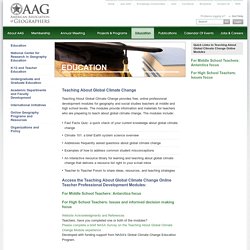
The modules provide information and materials for teachers who are preparing to teach about global climate change. The modules include: Fast Facts Quiz: a quick check of your current knowledge about global climate change Climate 101: a brief Earth system science overview Addresses frequently asked questions about global climate change Examples of how to address common student misconceptions An interactive resource library for learning and teaching about global climate change that delivers a resource list right to your e-mail inbox Teacher to Teacher Forum to share ideas, resources, and teaching strategies Access the Teaching About Global Climate Change Online Teacher Professional Development Modules: For Middle School Teachers: Antarctica focus. This Clever Device Turns Phones Into Sophisticated Eye Exam Machines. The most important medical invention of the last 10 years?
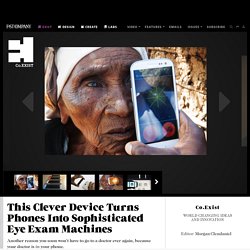
It could be the smartphone. Together with attachments, mobile phones can now be used for many health care tasks—from electrocardiography to ultrasound. And normally at a cheaper price. "M-health" opens up medicine to billions of people who've previously lacked access. Peek, a mobile-based eye exam kit, is another of the new breed. "It projects light with the correct intensity and angle to illuminate the retina," explains Mario Giardini, who developed the hardware. Teacher Resources, Classroom Activities, Literacy Frameworks, Journal, Web Seminars, Workshops, Online Courses, Tours, and Teacher Newsletter.
Science: Physical Processes. Earth and Space Science. Course Overview From the soil and rocks beneath our feet to our connection to the Moon and Sun, the story of Earth is a fascinating one — and most of what is known about the Earth has been gathered through observation and interpretation.
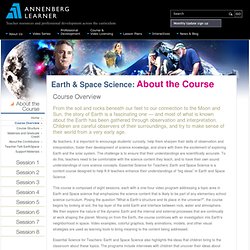
Children are careful observers of their surroundings, and try to make sense of their world from a very early age. As teachers, it is important to encourage students’ curiosity, help them sharpen their skills of observation and interpretation, foster their development of science knowledge, and share with them the excitement of exploring Earth and the solar system. The challenge is to ensure that their understandings are scientifically accurate. To do this, teachers need to be comfortable with the science content they teach, and to have their own sound understandings of core science concepts. Essential Science for Teachers: Earth and Space Science also highlights the ideas that children bring to the classroom about these topics. Session Descriptions. Teacher-Developed Lesson Plans. © 1995,1996The Regents of the University of California This site has been rated by the Doing Astrophysics Research with an Artificial Earth Orbiting Satellite, Sine Waves, The Electromagnetic Spectrum, Images of the Universe in Different Wavelengths, Satellite Communications, Satellite Dishes, Constellations and the Zodiac, Solar System Objects, Earthquakes, and More!
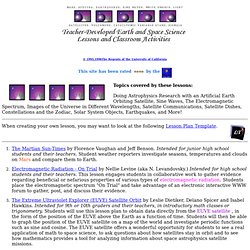
When creating your own lesson, you may want to look at the following Lesson Plan Template. The Martian Sun-Times by Florence Vaughan and Jeff Benson. Earth Science Lesson Plans. Earth & Space Science Explorers. Activities. MY NASA DATA Lesson Plans. The collection of MY NASA DATA lesson plans is intended to provide the educator with a variety of specific examples, incorporating a more “teacher-directed” strategy, of how authentic satellite data can be integrated into the curriculum.

The majority of MY NASA DATA lessons were developed by classroom teachers to use real NASA data in their curriculum. Other lessons were developed by the MY NASA DATA team as examples of lessons using microsets from the Data Access page. Featured on the Science Project Ideas section of our website are examples of a more “student-directed” strategy, with an inquiry-based research approach for using authentic data.
If you are a visitor to the MY NASA DATA site, these illustrations of how other teachers have used authentic satellite data as a resource may serve as an inspiration. We invite you to use them as is or to create your own lesson from the rich data resource that the LAS provides. Astrobiology: Life in the Universe. Glory. Glory will measure the effects of aerosols in the Earth's atmosphere.
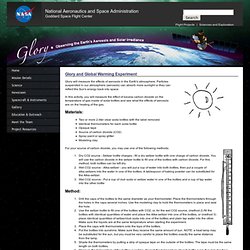
Particles suspended in our atmosphere (aerosols) can absorb more sunlight or they can reflect the Sun's energy back into space. In this activity, you will measure the effect of excess carbon dioxide on the temperature of gas inside of soda bottles and see what the effects of aerosols are on the heating of the gas. Materials: Two or more 2-liter clear soda bottles with the label removed.
Identical thermometers for each soda bottle Opaque tape Source of carbon dioxide (CO2) Spray paint or spray glitter Modeling clay For your source of carbon dioxide, you may use one of the following methods: Dry CO2 source - Seltzer bottle charges - fill a dry seltzer bottle with one charge of carbon dioxide. Method: